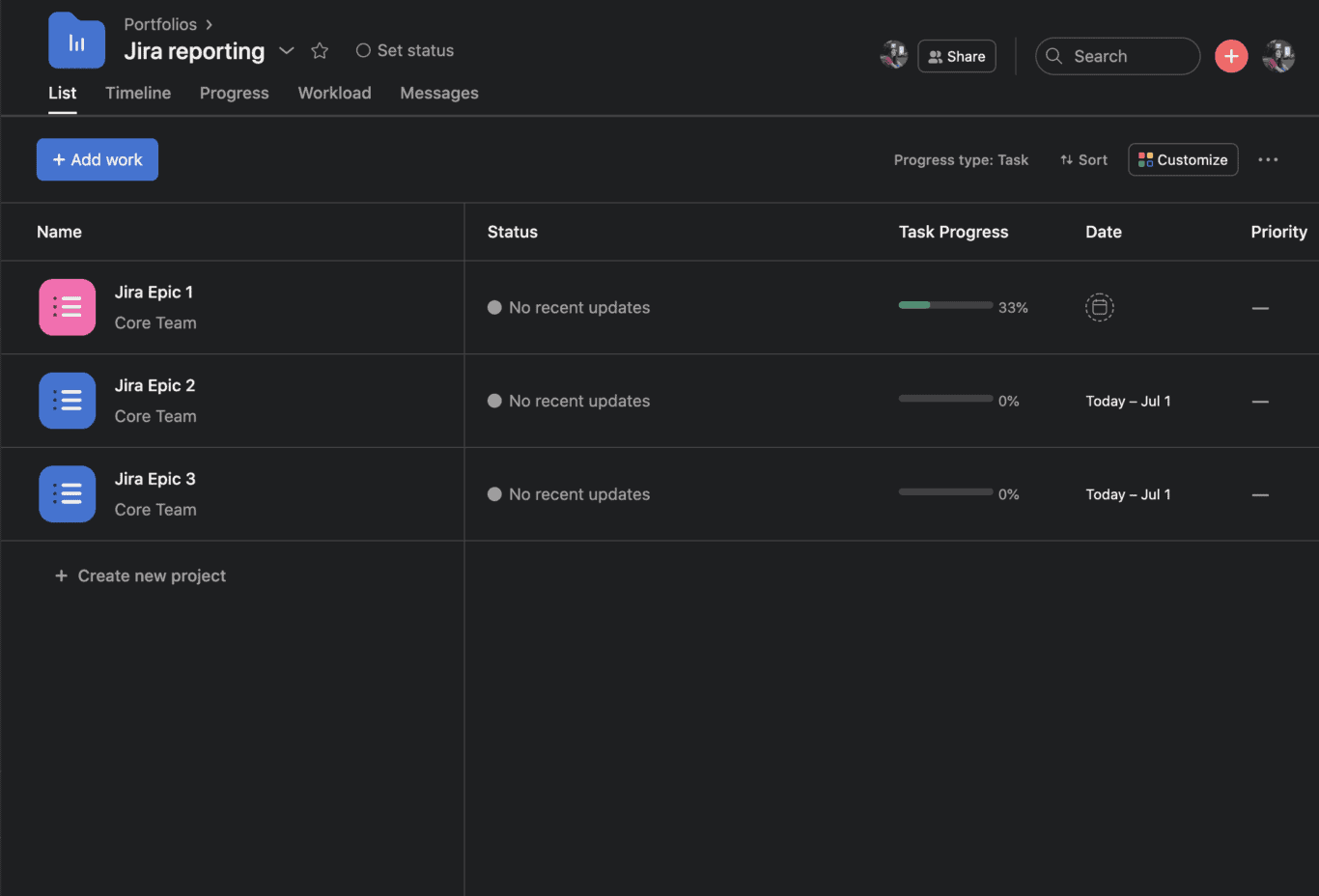How to Share Jira Epics in Asana Seamlessly with 2-Way Updates
This guide will show you how to connect Jira and Asana to report on epics with Unito’s automated 2-way workflow. You can also use this guide to share Jira epics to Trello, ClickUp, Wrike, monday.com or other project management tools by following the same steps.
Syncing Jira epics to Asana projects with Unito can save loads of time by eliminating manual tasks, such as copy-pasting details Jira issues to Asana tasks. It means your dev team, data engineers, product or project managers, and anyone else who uses Jira or Asana can work more efficiently. We sync epics by connecting all the issues of a given epic to a chosen Asana project.
This Jira Asana integration has two goals:
- Automatically populate an Asana project with issues from a single Jira epic.
- Maintain a real-time sync between issues and tasks so that teams can stay up-to-date on ticket progress even as work is performed.
Here is what our completed Unito integration between Jira and Asana looks like:


Why share Jira Epics in Asana with Unito?
The goal of this Unito flow to create a report in Asana based on Jira epics so a development team can quickly and easily share visibility with other departments. The benefit of doing so with Unito is that the dev team can continue to work on tickets and stakeholders will always see the latest progress from Asana. This is especially useful when non-dev teams aren’t as comfortable using Jira as a project management tool. It means no one needs to waste time copy-pasting details from Jira to Asana that quickly become outdated as soon as they move on to the next project.
Here’s a quick demo from one of our product specialists:
Before we sync our Jira epic to an Asana project
First, you need to know where you want your Jira issues to go. For our demo, we’ll create an Asana project called “Epic 1” to which we’ll sync all Jira issues from a similarly-named epic. This epic will include open and archived issues so that even completed items in Jira will also sync to Asana in order to keep other teams looped in on progress. Then, there are a few other things to keep in mind:
- The Jira account connected to Unito must have administrator access with global permissions.
- You’ll need to configure Jira for Unito access before building your flow, if you have not previously done so.
Step 1. Connect Jira and Asana to Unito
Navigate to the Unito App and select +Create Flow. On the next screen, select Start Here to connect Asana and Jira. Choose the accounts you want connected to Unito. You’ll need to specify which account for each tool you wish to connect through Unito, as well as the project names you wish to sync. Although we’re going to sync epics from Jira to Asana, our work items are still tasks and issues, as you can see below:

When you’re ready, click Confirm.
Step 2. Set a flow direction between Jira and Asana
Your data can sync either from only one tool to the other or bidirectionally. Since our goal is to inform teams in Asana of our progress in Jira, we’ll select a one-way flow from Jira to Asana.

Click Confirm when you’ve chosen a flow direction.
Step 3. Set up rules to sync Jira epic issues to Asana tasks
Your rules will determine how Jira issues from your epics will be created automatically in Asana. This is our chance to filter out unrelated work to focus solely on the epics we’re interested in.
Select Add a new trigger to set additional triggers to specify the information you want included in the flow.

Find out more about setting rules.
Step 4. Select field mappings to sync Jira issues and Asana tasks
Field mappings determine which details of our synced issues and tasks are then shared between tools. If you select Auto-map, Unito will pre-populate a list of suggested field mappings which you can then adjust. If you know exactly how you want your fields mapped, Start from scratch.
Learn more about field mappings between Asana and Jira.

Select + Add mapping to sync additional fields, then Select a field for each tool, and find the appropriate field to map. Here are our fully-mapped fields for this demo:

Selecting the gear icon beside a field will allow you to customize the values or statuses within those fields to further customize your flow. In the example below, we have told the system to match Jira issue stats to Asana status based on certain parameters:

Click Confirm when you’re satisfied with your field mappings to proceed.
Find out more about setting field mappings.
Step 5. Save, launch your Jira to Asana flow and go!
And that’s it! You’ve just completed a flow between Jira and Asana to share epic status with other teams. Congratulations!
If you’ve followed the steps above, your flow will now:
- Create a task in Asana for every open or archived Jira issue in our specified project.
- Allow teams to collaborate between both tools without needing to leave their preferred interface, copy-paste data manually, or request information from the other team about these projects.

If you have any questions, don’t hesitate to reach out and let us know. Our live support team is ready to jump in and lend a hand to make sure your flows always function as intended.
What’s next after sharing Jira Epics in Asana projects?
- Learn how to duplicate this flow to share progress on multiple Jira epics at once.
- Read more about Unito’s integrations for Asana and Jira to better understand their capabilities and limitations.
- Build an automated ticket escalation queue from Jira Service Management to Jira Cloud.
